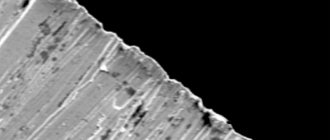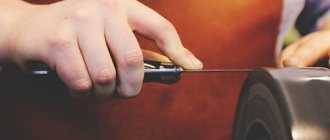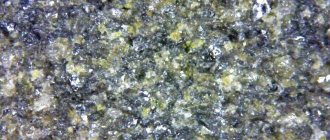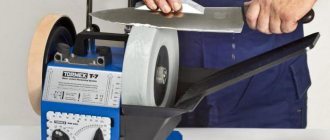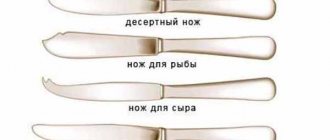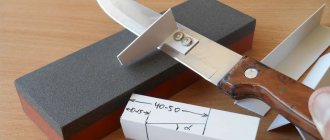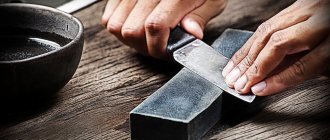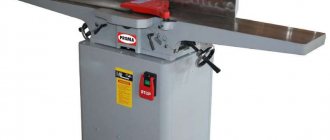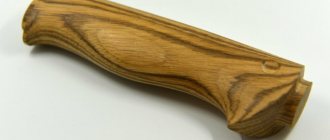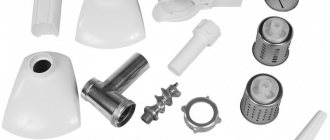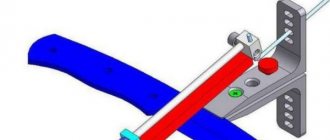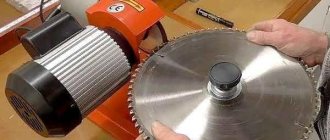The use of even a branded surface planer, produced using advanced technologies, requires periodic updating of some of its parts. The knives of this equipment must always be kept perfectly sharp, because the longer you do not correct the situation, the more difficult it will be to return the blades to their original sharpness.
Tool sharpening prices
Knives for thicknessers and jointers can be sharpened many times; I remove the minimum required layer of metal using the correct sharpening equipment.
| Video examples of our work on sharpening knives for surface planers and other tools |
Sharpening thicknesser knives in our sharpening studio costs 150 - 300 rubles.
We sharpen nail scissors and tools, knives, including ceramic ones.
Why is timely and correct sharpening necessary?
Planing knives, like other cutting tools, require maintenance for certain reasons:
- with a blunt blade of planing knives, the wood will be processed very poorly;
- when working with soft types of wood, pile and various irregularities will form on the surface;
- the worn edge will crumble;
- When planing with blunt tools, the machine motor overloads
Even if you decide to sharpen it yourself using diamond stones, the effect of such work will be very insignificant. You'll have to resharpen them soon. For these reasons, people who plan professionally choose only automatic or mechanical sharpening.
Sharpening process and operating rules
The holder moves to the right and left, movements are made relative to the sharpening stone. The blade should not be allowed to go beyond the edge. It is best to immediately install the holder 12 mm from the edge of the working circle. If sharpening is carried out, water cooling must be supplied. You will have to add water to the tank, you need to make sure that it does not run out. It is necessary to ensure that water does not accumulate on the floor near your feet. This is done for security reasons.
When performing work, you must ensure that the stone remains clean at all times, as it gets dirty quite quickly. A special whetstone is used for cleaning; it is recommended to carry out this procedure frequently, since only clean stones can be used for sharpening. The choice of stone itself depends on what kind of knives are used. Today, manufacturers produce jointing knives from soft or hard tool steel, so working conditions will vary.
Sharpening takes approximately 20 minutes, then fine-tuning is done. A special paste is used for this. After polishing, there should be no burrs left on the surface, otherwise the jointing knife will not be ready for use. The test is simple to carry out; a finished knife with excellent sharpening should easily and evenly cut a sheet of paper while hanging, leaving a neat cut.
Return to contents
Preparing the workplace and equipment, installing the screw that controls the angle
To sharpen knives, you will need a special sharpener, but you must use modern variations of it with a low speed, which have water-type cooling. The Tormek T7 with a special Tormek SVH holder is most suitable for these purposes. A smooth and clean sharpening stone will help you complete this process efficiently. In the future, a practical example will be considered based on a set of Tormek equipment.
When sharpening, you need to install a screw with which you can change the sharpening angle, but first you need to prepare the workspace by fulfilling certain conditions:
- We install the Tormek SG250 sharpening stone, leveling it using a special tool Tormek TT-50. The device comes complete with T7.
- It is necessary to smooth the sharpening stone using a cleaning and leveling stone.
- We remove the standard stop and install a specialized stop.
- We screw in the screw itself, which can later be used to adjust the angle of the chair being sharpened.
- We install a special holder for the blade.
It is recommended to sharpen cutting tools whose width is more than 12 millimeters. And the length of the knife no longer matters. In addition, you can rearrange long knives. Correct installation of the blade in the holder is of great importance, because sharpening with large distortions is possible. Correctly this process is performed as follows: install the back of the knife all the way and clamp it with special holders.
Preparing to sharpen knives
Sharpening jointer knives can be done more efficiently if you choose a device with low speeds and high quality. If you want to use a whetstone, you must first level it. After straightening the device, the stone must be smoothed with a block.
Now set the appropriate angle of inclination, this is done by rotating the screw securing the blade. Next, you need to use the holder that is included in the standard equipment of the machine, where the jointing knife is fixed. Work should begin with knives no wider than 13 mm. The length is not important, since the holder holds the tool in a comfortable position.
To secure the knife well, hold it in the selected position and tighten the screws tightly.
To control the sharpening angle of the jointer knives, a marker is used to mark the chamfer of the knife. To understand the accuracy of the adjustment, you can turn the stone manually.
Estimating and setting the required inclination angle
By analyzing the characteristics of the marks left by the sharpening stone, it is possible to correctly assess the angle of inclination by selecting the desired proportions. Then a holder with a knife is installed on the fixed stop. Adjustment is carried out using the stop screws; you need to lower the holder until it touches the stone. Using the angle adjustment screws, select the required parameter in relation to the stone. When rotating manually, the marks on the painted blade determine the need to adjust the angle of the holder. And if necessary, such adjustments are very easy to make.
Operating angle range 30-45 degrees. Its exact degree is determined by the specific type of tree. A 1985 handbook written by Karl Fronius states that quality will depend not only on the angle, but also on the blade's reach and head diameter. The classic parameter is considered to be 40 degrees. When choosing a specific number, do not forget that the cutters are designed according to a standard backing. If you increase the angle, there is a risk of the butt rubbing against the workpiece. And if you reduce it, the cutting edge will become weaker and thinner.
Homemade knife sharpening machine
The manufacture of homemade machines is most often due to two reasons. The first is the desire to save money. The second is to show your skill and do everything with your own hands exactly as your soul desires.
For example, very often you may be faced with the need to tidy up only certain tools. These can be drills, cutters, saws or jointing knives.
Each specific case requires a separate approach. Self-assembly of the machine will allow you to create a convenient unit for working with certain elements.
Among other things, the presence of sharpening units will significantly save costs aimed at purchasing new knives or restoring them in third-party workshops.
In addition, purchasing in a store guarantees that the device will solve the assigned tasks for a long time. You should also remember the degree of automation. Of course, professional devices use electronics that are simply impossible to make at home without the proper experience.
Option 1
A homemade machine for sharpening a planer will not only keep the tool in good condition, but will also save time on trips to other workshops.
One option for creating such a device is to use a motor with an abrasive wheel, emery cloth, or a sharpening device with a knife fixed in it.
This device can be made partly from aluminum, metal and wood. In this case, bearings and guides are used, made from scrap materials, for example, pipe corners or others.
When the knives are level, they can be sharpened on a large abrasive stone. If this is not available, you should use sandpaper glued to a flat surface.
Depending on the requirements for the final result, you can vary the speed of this process. If there are dents, you must first use a belt sander, and at the final stage, treat the tool with an abrasive stone or a homemade one made from sandpaper.
The design features of the machines may also differ from each other. The first option is a device with a fixed base. Its angle of inclination can be changed, but otherwise it is in a fixed position.
The bar is attached to a rod, which is inserted into the loop of a movable clamp located on another rod. The disadvantage of this design is the “walking” angle due to the lack of rigid fixation.
The knife is installed using two steel plates fixed to a fixed platform. Having loosened the fasteners, insert the blade and clamp it. Then adjust the height of the bar so that the required angle is set.
Option 2
The second type of design provides a movable platform, as well as a magnetic holder. This option does not have the disadvantages of the previous unit. Fixed in this device is a frame with a bar that determines the angle.
The knife, in turn, is mounted on a movable table. The choice of holder remains with the master. You can use a magnetic type or a regular one, made of metal plates and “lambs”.
Some rules and features of sharpening
Having set the angle of inclination to the desired position, you can begin the sharpening process itself. You can record the amount of metal being removed; two sliders with a scale and 0.1 mm division are designed for this purpose. The sharpening specialist will be able to adjust this parameter quite accurately. Do not forget to securely fix it with special clamps after each filing to prevent vibrations during sharpening.
The sharpening process itself is carried out by changing the position of the holder in relation to the sharpening stone. It is important to ensure that the knife does not go beyond the extreme point of the stone. It is advisable to stop the holder 10 mm from the edge. Separate stops are provided as a braking element, by moving which the desired stroke is set. The decisive factor here will be the experience of the person who sharpens the planing knives. During the process itself, water is formed, which accumulates and collects on the blade. Then it flows onto the body itself and onto the floor. A lot of water is wasted, so don’t forget to constantly add it to the special section. And the spill itself can be reduced by placing some kind of pad under the leg, 6 mm high.
Another nuisance during sharpening will be the constant clogging of the sharpening stone, which affects the duration of this work. It is best to periodically clean it with the SP-650 bar provided for this purpose. When working with soft metal, sharpening will go much faster and the stone will have to be cleaned less often, because such material is removed in fairly massive sections.
After half an hour of work, you get an even chamfer with a stable burr. All that remains is to polish it using a leather wheel and polishing paste. First of all, you will need to complete the plane of the knife, and only then the chamfer itself.
Features of working with a manual machine
Manual machines are used only in cases where it is necessary to sharpen not too many knives. Otherwise it would have taken a lot of time. But if you need to sharpen several knives, then this method will be quite acceptable, but you must adhere to the following rules:
- you need to check the surface of the stone, because the use of such machines is only possible with clean sharpening tools;
- try to make sure that the carriage with the attached knife is brought in quite smoothly, without any sharp jolts;
- the speed of movement of the carriage should not exceed 6m/min, high speed may damage the blade;
- During one pass, the carriage must advance a distance that is 15 cm greater than the length of the knife.
Features of working with an automatic machine
- the wet method is more suitable for sharpening planing knives, because the blade is constantly cooled;
- at the preparation stage, you already need to set all the parameters, including the angle of inclination and the distance of movement of the carriage;
- the most important factor is the installation of knives on the carriage;
- the process should be carried out quite smoothly, without sudden twitching
Preparatory activities
Diagram of the device for sharpening knives of woodworking machines
If you need to sharpen knives for a woodworking machine, you should start with the required preparation steps. It is not so important what parameters the knife shaft or cutting sheets of hacksaws have 13 mm, 20 mm or all 200 mm, they will definitely need sharpening.
Some people prefer to send dull shafts to special workshops, where they can easily restore the previous sharpness of a 200 mm knife or a small lathe cutter. But both ordering sharpening and buying new knife shafts is a financially expensive matter.
Preparation for sharpening begins with familiarization with the available means of restoring the surfaces of cutting tools and some recommendations.
- To keep jointers, planers, and hacksaws in working order, assemble or purchase an appropriate sharpening device.
- The simplest, budget option is a whetstone. But the quality of processing directly depends on your skills in working with stone. If there are none, it is extremely difficult to achieve the required level of sharpening. Plus, stones are not able to cope with all types of cutting tools that are equipped with modern woodworking machines.
- Choose a machine that can sharpen at low speeds, as this has a positive effect on the quality of the finish.
- The recommended equipment for a sharpening machine is a water cooling system.
- Carefully study the equipment of household woodworking machines. Often there is already a sharpening stone, which is optimally suited for processing the knives used.
- If the stone is not included in the package, it will have to be purchased separately, leveled with a special device, and smoothed. This is the only way you can sharpen the knife shafts of jointing machines efficiently.
- The machines have a function for setting the angle of inclination, adjustable with a special screw. By turning the screw and changing the position of the sharpening device, you can correctly fix the tool relative to the stone.
- The next preparatory stage is the holder into which the knife shaft is installed.
- If you are a beginner, it is not recommended to start your first job with 200 mm knives. Start literally with 13-15 mm, and gradually you will learn to process 200 mm and even 2 mm. To do this you need to accumulate certain experience.
- The length of the knife is not a fundamental parameter, since the knife in the holder can move to the distance you require.
- Make sure to hold the shaft firmly in place. Otherwise, you will get a significant distortion, due to which the quality of woodworking will suffer.
- Study the operating manual of the purchased sharpening machine in detail. If this is a DIY tool, you will have to rely on drawings and available information on the Internet about a specific sharpening device project.
Sharpening
In order for the sharpening of knives for a woodworking machine to give a positive result, you can resume working with the equipment at the same level of quality, you need to adhere to a few fairly simple rules.
- The sharpener holder can move left and right relative to the stone to sharpen knives.
- Do not allow the blade to end up over the edge.
- Immediately fix the holder at a distance of 12 mm from the edge of the grinding wheel.
- When sharpening knives of 200 mm or smaller variations, make sure that the water cooling function is activated on the machine.
- The cooling system requires constant monitoring. The tank usually has a small volume, so water needs to be added periodically. If it runs out and the sharpening process continues without cooling, you risk ruining a rather expensive knife.
- As the knives are processed, water from the cooling system may accumulate on the floor. Since sharpening machines are electrical devices, ensure that water is drained away from your feet and wear rubber shoes. In any case, standing in a puddle of water while working with an electric machine is always dangerous. Follow safety regulations.
- Keep the whetstone clean. It gets dirty quite quickly with active use.
- The grinding wheels of machines are cleaned using a special device. The machines should be equipped with this cleaning bar, but if it is not included in the set, then you will have to purchase it separately.
- Each subsequent sharpening, according to the operating rules, is performed only on the condition that the stone is cleaned. Therefore, after each sharpening, arm yourself with a cleaning bar and treat the machine with it.
- On average, sharpening using a special machine takes about 10-20 minutes. It all depends on the type and size of the tool, which became dull as a result of woodworking operations.
- After sharpening the tools of woodworking machines, do not rush to return them to their place and continue working. After processing on the machine, the tool needs to be fine-tuned.
- Finishing consists of applying a special paste to the surface of the cutting element. Proceed according to the instructions provided by the manufacturer of the finishing paste on the packaging. Different pastes may differ slightly in application methods.
DIY sharpening machine
If desired, it is possible to assemble the sharpening machine yourself. You will need the following items: table, faceplate, vacuum cleaner, motor and machine cover. The faceplate will become the main and most expensive component. It is advisable to choose American or German manufacturers. Then an engine with a power of 1.5 kW is selected; even supported options are suitable. For example, you can purchase motors from washing machines.
The motor must be installed under the tabletop, and the faceplate must be secured to the moving element. Don't forget to consider the on and off buttons. You need to put a casing on the faceplate, cutting off one side, from which sharpening will be done. You will also need to make a cutout at the bottom of the tabletop for a vacuum cleaner. This machine is also suitable for working with other cutting surfaces.
How to properly sharpen knives on a sharpening machine
The blade of the best quality knife needs sharpening periodically. A person who takes on this task without knowledge will most likely not avoid mistakes and will grind down the instrument in several repetitions. To properly sharpen a knife on a sharpening machine, you need to select the capabilities of the machine for the type of product.
Types of sharpening machines
The most important characteristics of sharpening machines are:
- blade material (coarse and fine-grained abrasives, diamond-coated blade, ceramics, carbide);
- the presence or absence of an angle adjustment option;
- equipped with a blade lock.
For proper sharpening, the simple Soviet method is also suitable, in which the cutting edge is leveled and polished using a whetstone. This will require knowledge of technology, otherwise there is a chance of grinding off excess or repeating the procedure too often.
There are also more expensive attachments for knives. Some sharpening machines are equipped with electric motors.
Electric sharpeners
Electric sharpeners are a modern alternative to whetstones and whetstones. These devices can be adjusted to suit different types of blades. The knife is guaranteed not to be damaged. Sharpening one product, often together with grinding, takes up to 2-3 minutes.
Electric sharpeners differ in power levels and additional equipment. The most expensive and professional cutters are equipped with three grooves with different disks. They provide a three-step process and not only sharpen the cutting edge, but also polish it.
An expensive tool is necessary when you need to sharpen ceramic and exclusive products made from elite materials. Ceramic kitchen knives have become popular, but they are difficult to sharpen without preparation. There is a risk of crumbling and deforming the cutting part.
Mechanical type sharpeners
While complex electrical devices are more suitable for professional use, mechanical sharpeners are suitable for household use. Among them:
- v-shaped sharpeners (quickly lead to wear on the knife);
- roller blades.
This type of sharpening device is more complex than a regular whetstone. However, it does not require a power source. A mechanical knife is based on two elements: a handle for the stop and a pair or several pairs of disks for the blades. The angle between the abrasive discs is already preset; you just need to select a groove and fix the edge.
Mechanical sharpeners of varying degrees of complexity may also include devices for polishing, clamps, and additional abrasive discs.
Rules for sharpening knives
General principles of sharpening:
- the cheaper the knife, the softer the steel in it - it is easier to sharpen it, but it will become dull again faster;
- kitchen products are sharpened more easily than tourist ones;
- any sharpening consists of 3 parts: forming an angle, eliminating defects, making it smooth.
With the correct sharpening method, you should adhere to the following procedure:
- First use a coarse-grained block, then a fine-grained one if you are processing a mid-price product.
- Use a diamond-coated blade if we are talking about ceramics.
- Determine the angle corresponding to the blade - apply the cutting plane to the surface of the abrasive and move it several times.
- Make back-and-forth movements on one side until a protrusion forms on the other side.
- Change the side, cutting off the defect that has arisen, and sharpen the cutting edge on the other side.
When sharpening correctly, the maximum accessible surface of the knife is applied to the abrasive. It is a mistake to sharpen only the “target” area of the blade. Special machines are designed in such a way that almost the entire cutting part of the product comes into contact with the abrasive.
To complete the process, the blade can be brought to perfection by grinding and polishing. Sharpening rules are more relevant when you need to sharpen knives yourself - on sandpaper, using abrasive stones or whetstones.
How to sharpen knives on a sharpening machine
Correctly sharpening a knife on a machine requires several stages. This is the main rule, and it is failure to comply with it that leads to edge wear.
Mechanical and electrical devices sharpen blades autonomously and quickly. On the part of the owner, it is enough to fix the blade in the groove - the necessary axes and angles are already set. On mechanical sharpeners you need to move the knife back and forth. Although you can sharpen all types of knives yourself, it is better to give works of art to a master for sharpening.
However, in ordinary workshops one encounters the use of overly powerful electric sharpeners. This leads to the destruction of the edge.
How to sharpen a knife with a knife sharpener
When using a conventional sharpener, pay attention to three conditions:
- The abrasive must match the type of blade material. Ceramics require special care.
- It is necessary to maintain the natural sharpening angle.
- For softer materials, use coarse-grained abrasives; for harder materials, use diamond-coated sharpeners.
Electric sharpeners provide angle adjustment. To sharpen a product with such a sharpener, the recommendations in the instructions for it are sufficient.
This is the advantage of more expensive tools - all the rules are followed by the device itself.
Grinding
During processing, a sharpened knife develops microprotrusions and fractures—burrs. These defects are eliminated at the final stage for kitchen knives - grinding.
The grinding function is usually already built into the machines. It is done manually using a fine-grained abrasive. More professional products are polished at the end of processing.
When polishing yourself, you can use stretched leather - a special paste is applied to it. You should move the blade along the skin with movements toward you (towards the handle).
If sharpened correctly, the product will be razor sharp and will last a long time. Universal sharpeners allow you to bring not only knives to this state, but also, for example, scissors.
Sharpening knives in specialized workshops
If you are unable to organize the correct sharpening of planing knives or it becomes difficult to set the desired level of inclination, then contacting a workshop will be an excellent solution to the problem. This method has the following advantages.
- Expensive and high quality equipment is used. The straightness of the cutting edge will be much better than when processing it yourself.
- Modern cooling systems are used that will prevent the cutting surface from overheating and collapsing.
- Additional materials and special technologies are used to refine the knife, which affects the functionality and service life of such knives.
- In a workshop environment, it is possible to obtain the most even edge due to the absence of overheating and weight differences. In practice, the result should be an ideal instrument.
Sharpening planing knives
Sharpening planer knives is a process that requires precision and careful approach. If, when processing wood, the blade of a planing knife becomes dull, or any irregularities or nicks form on it, you just need to pay attention to this! Sharpening planer knives requires high precision processing. Special equipment must be used to process these high quality blades.
It is most convenient to sharpen a planing knife on a special sharpening machine. In this case, sharpening of planing knives must be carried out in compliance with high precision processing of the knife surface. After all, it is in this way that the geometry of the blade is preserved as much as possible and the angle at which sharpening occurs is adjusted.
Those who often encounter sharpening work usually do one of the following methods. Some people buy their own sharpening equipment and independently monitor the condition of the cutting surfaces in their machines. Others prefer to use a sharpening service, saving themselves from this painstaking process. Which path to choose depends only on your practical needs and common sense.
